The 20th century BC was a century which lasted from the year 2000 BC to 1901 BC.

A mastaba or pr-djt is a type of ancient Egyptian tomb in the form of a flat-roofed, rectangular structure with inward sloping sides, constructed out of mud-bricks. These edifices marked the burial sites of many eminent Egyptians during Egypt's Early Dynastic Period and Old Kingdom. In the Old Kingdom epoch, local kings began to be buried in pyramids instead of in mastabas, although non-royal use of mastabas continued for over a thousand years. Egyptologists call these tombs mastaba, from the Arabic word مصطبة "stone bench".

Senenmut was an 18th dynasty ancient Egyptian architect and government official. His name translates literally as "mother's brother."
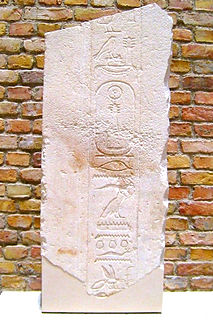
Djedkare Isesi was a pharaoh, the eighth and penultimate ruler of the Fifth Dynasty of Egypt in the late 25th century to mid-24th century BC, during the Old Kingdom. Djedkare succeeded Menkauhor Kaiu and was in turn succeeded by Unas. His relations to both of these pharaohs remain uncertain, although it is often conjectured that Unas was Djedkare's son, owing to the smooth transition between the two.

Ancient Egyptian art refers to paintings, sculptures, architecture and other arts produced by the civilization of ancient Egypt in the lower Nile Valley between the periods of about the 31st century BC to the 4th century AD. Ancient Egyptian art reached a high level in painting and sculpture and was both highly stylized and symbolic. It was famously conservative, and Egyptian styles changed remarkably little over the three thousand-year period. Much of the surviving art comes from tombs and monuments which have given greater insight on the Egyptians belief of the afterlife and has caused a greater focus on preserving knowledge of the past. Wall art was not produced to be seen, rather had a purpose in the afterlife.

Hemiunu is a man who lived in Ancient Egypt and he is believed to be the architect of the Great Pyramid of Giza, Egypt. As vizier, Hemiunu was one of the most important members of the court and responsible for all the royal works. His tomb lies close to Khufu's pyramid. As vizier he succeeded his father, Nefermaat, and his uncle, Kanefer.
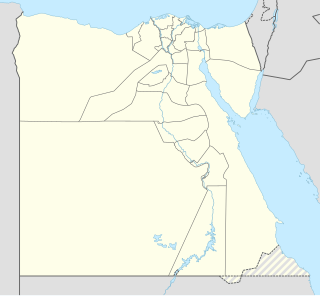
Lisht or el-Lisht is an Egyptian village located south of Cairo. It is the site of Middle Kingdom royal and elite burials, including two pyramids built by Amenemhat I and Senusret I. The two main pyramids were surrounded by smaller pyramids of members of the royal family, and many mastaba tombs of high officials and their family members. They were constructed throughout the Twelfth and Thirteenth Dynasties. The site is also known for the tomb of Senebtisi, found undisturbed and from which a set of jewelry has been recovered. The pyramid complex of Senusret I is the best preserved from this period. The coffins in the tomb of Sesenebnef present the earliest versions of the Book of the Dead.

Spanning over two thousand years in total, what is called ancient Egypt was not one stable civilization, but instead a civilization in constant change and upheaval commonly split into periods by historians. Likewise, ancient Egyptian architecture is not one style, but a set of styles with commonalities used during each period of ancient Egyptian history.
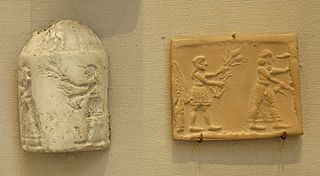
A cylinder seal is a small round cylinder, typically about one inch in length, engraved with written characters or figurative scenes or both, used in ancient times to roll an impression onto a two-dimensional surface, generally wet clay. Cylinder seals were invented around 3500 BC in the Near East, at the contemporary sites of Uruk in southern Mesopotamia and slightly later at Susa in south-western Iran during the Proto-Elamite period, and they follow the development of stamp seals in the Halaf culture or slightly earlier. They are linked to the invention of the latter’s cuneiform writing on clay tablets. They were used as an administrative tool, a form of signature, as well as jewelry and as magical amulets; later versions would employ notations with Mesopotamian cuneiform. In later periods, they were used to notarize or attest to multiple impressions of clay documents. Graves and other sites housing precious items such as gold, silver, beads, and gemstones often included one or two cylinder seals, as honorific grave goods.

The Tomb of Perneb is a mastaba-style tomb from ancient Egypt, built during the reigns of Djedkare Isesi and Unas, in the necropolis of Saqqara, north of Pharaoh Djoser's Step Pyramid and about 30 kilometers south of Giza, Egypt. It was the tomb of Perneb, and from the size and placement of the tomb he might have been a court official or royal family member.
Carl Nicholas Reeves, FSA, is an English Egyptologist, at the Egyptian Expedition, University of Arizona.

The crook (heka) and flail (nekhakha) are symbols used in Ancient Egyptian society. They were originally the attributes of the deity Osiris that became insignia of pharaonic authority. The shepherd's crook stood for kingship and the flail for the fertility of the land.

Etruscan art was produced by the Etruscan civilization in central Italy between the 9th and 2nd centuries BC. From around 600 BC it was heavily influenced by Greek art, which was imported by the Etruscans, but always retained distinct characteristics. Particularly strong in this tradition were figurative sculpture in terracotta, wall-painting and metalworking especially in bronze. Jewellery and engraved gems of high quality were produced.

The Ancient Egyptian official Meketre was chancellor and high steward during the reign of Mentuhotep II, Mentuhotep III and perhaps Amenemhat I, during the Middle Kingdom.
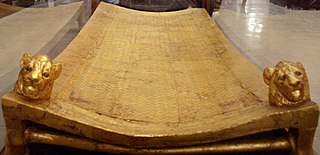
Exhibitions of artifacts from the tomb of Tutankhamun have been held at museums in several countries, notably the United Kingdom, Soviet Union, United States, Canada, Japan, and France.
The ancient Egyptian Game piece (hieroglyph), also a Token, or the general term for any gaming-gambling piece, Draughtsman is an ancient hieroglyph. Gaming pieces were certainly required in predynastic times, as the cultural creation of games and entertainment has a long history in most cultures. An ivory-piece lion is known from the Old Kingdom of Ancient Egypt; the set contains three lions, and three dog tokens of ivory.
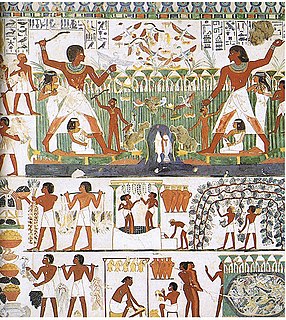
The Egyptologists Nina M. Davies and Norman de Garis Davies were a married couple of illustrators and copyists who worked in the early and mid-twentieth century drawing and recording paintings in Egypt. Their work was often published together, as N. de Garis Davies, and so it is usually difficult to determine who drew which illustration.
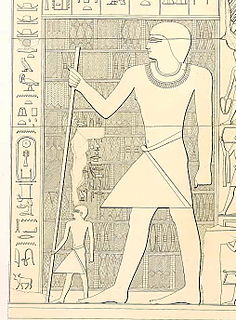
Rashepses was a vizier from the Fifth dynasty of Egypt. Rashepses was vizier under Djedkare Isesi. A letter directed to Rashepses has been preserved. This decree is inscribed in his tomb in Saqqara. As vizier he was one of the most important Ancient Egyptian officials. In his tomb are many titles recorded. It seems that he was first overseer of the scribes of the royal documents, overseer of the two granaries and overseer of all royal works. These are all very important titles, making him an influential official at the royal court. At the final stage of his career he became vizier. The vizier title is only preserved in two letters that are copied on the decoration of the tomb. It seems that most of his tomb was finished and after all that, he was promoted.

William is the nickname of a faience hippopotamus from the Middle Kingdom of Egypt in the collection of the Metropolitan Museum of Art who serves as an informal mascot of the museum. Found in a shaft associated with the Upper Egypt tomb chapel of "The Steward, Senbi" in what is now Meir, Egypt, William dates from c. 1961 – 1878 B.C. during the reigns of Senusret I and Senusret II. This small figurine in Egyptian faience, a clay-less material, has become popular not only for his endearing appearance but also because his defining characteristics illustrate many of the most salient facets of craft production in ancient Egypt during this time.

The Cavern deities of the underworld were ancient Egyptian minor deities charged with punishing the damned souls by beheading and devouring them.






















